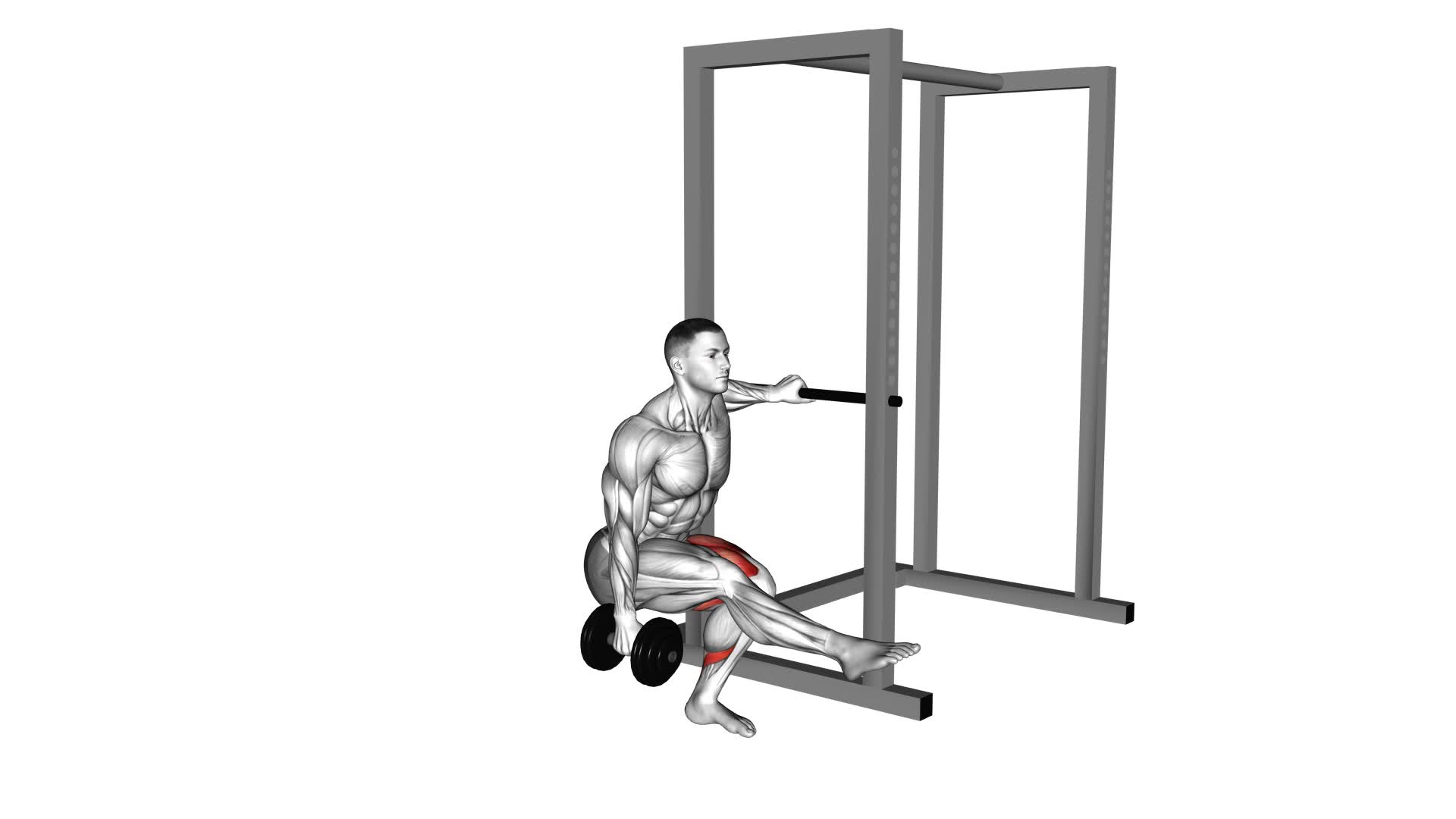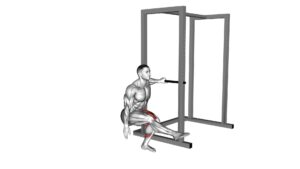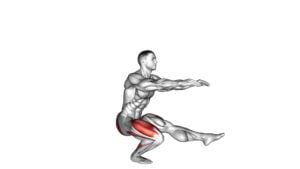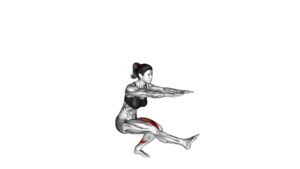Dumbbell Single Leg Squat With Support (Pistol) – Video Exercise Guide & Tips

Are you looking to strengthen your legs and improve your balance?
Watch This Exercise Video
The Dumbbell Single Leg Squat with Support, also known as the Pistol, is a fantastic exercise to add to your routine.
In this video exercise guide, we'll show you the proper form and technique, as well as provide tips for choosing the right dumbbell and support.
Avoid common mistakes and learn progressions for increased difficulty.
Get ready for a safe and effective workout!
Key Takeaways
- The dumbbell single leg squat strengthens leg muscles, including the quadriceps, hamstrings, and glutes.
- Proper form and technique, such as maintaining balance, engaging the core, and avoiding common mistakes, are crucial for performing the pistol squat correctly.
- Balance and stability techniques, such as practicing single-leg balance exercises and incorporating core-strengthening exercises, can enhance the performance of the pistol squat.
- It is important to avoid common mistakes like not maintaining proper balance control, leaning too far forward or backward, and incorrect foot placement, as these can disrupt balance and strain joints.
Benefits of the Dumbbell Single Leg Squat
One major benefit of the Dumbbell Single Leg Squat is that it strengthens your leg muscles, specifically targeting the quadriceps, hamstrings, and glutes. This exercise is a modification of the traditional pistol squat, where you hold a dumbbell for added resistance. By performing the Dumbbell Single Leg Squat, you activate these muscles, helping to increase their strength and endurance.
When you perform the Dumbbell Single Leg Squat, your quadriceps are heavily engaged as they work to extend your knee and stabilize your leg. The hamstrings, located at the back of your thigh, also play a significant role in this exercise. They work to bend your knee and control your descent. Additionally, the glutes, which are the muscles in your buttocks, are activated as they help to stabilize your hips and maintain balance throughout the movement.
By targeting these specific muscle groups, the Dumbbell Single Leg Squat helps to improve your overall lower body strength and stability. It can also help to improve your balance and coordination. So, if you're looking to strengthen your leg muscles and enhance your lower body performance, incorporating the Dumbbell Single Leg Squat into your fitness routine can be highly beneficial.
Now that you understand the benefits of the Dumbbell Single Leg Squat, let's move on to discussing the proper form and technique for the pistol squat.
Proper Form and Technique for the Pistol Squat
To perform the pistol squat with proper form and technique, you need to focus on balance and stability techniques.
Keep your core engaged and maintain a neutral spine throughout the movement.
Avoid common mistakes such as leaning forward, lifting your heel, or letting your knee collapse inward.
Balance and Stability Techniques
To improve balance and stability during the pistol squat, you need to focus on engaging your core and maintaining a strong center of gravity. Incorporating balance techniques and stability exercises into your training routine can help you achieve this.
One effective technique is to practice single-leg balance exercises, such as standing on one leg with your eyes closed or using a balance board. These exercises challenge your stabilizer muscles and improve your overall balance.
Additionally, performing exercises that target your core, such as planks and Russian twists, can help strengthen the muscles that support your spine and pelvis during the pistol squat.
Remember to start with lower intensity exercises and gradually increase the difficulty as your balance and stability improve.
Common Mistakes to Avoid
Ensure proper form and technique for the pistol squat by avoiding these common mistakes.
One mistake to avoid isn't maintaining proper balance control. It's important to keep your core engaged and your body aligned throughout the movement.
Another mistake to watch out for is inadequate muscle activation. Make sure to engage your glutes, quads, and hamstrings throughout the exercise to maximize the benefits.
Additionally, avoid leaning too far forward or backward during the squat, as this can disrupt your balance and put unnecessary strain on your joints.
Lastly, be mindful of your foot placement. Keep your foot flat on the ground and distribute your weight evenly for optimal stability.
Choosing the Right Dumbbell and Support
When choosing the right dumbbell and support for the Dumbbell Single Leg Squat With Support (Pistol) exercise, consider your fitness level and desired level of challenge. Here are some factors to keep in mind:
- Dumbbell selection: Choose a weight that challenges you but still allows you to maintain proper form. Start with a lighter dumbbell if you're a beginner and gradually increase the weight as you get stronger.
- Support options: Depending on your stability and balance, you may need different types of support to perform this exercise safely. Options include holding onto a sturdy object like a railing or using a stability ball against a wall for added balance.
- Comfort and grip: Make sure the dumbbell you choose feels comfortable in your hand and allows for a secure grip. You don't want the weight slipping out of your hand during the exercise.
- Adjustability: If you have access to adjustable dumbbells, it can be beneficial as you can increase or decrease the weight according to your needs and progression.
- Safety considerations: Always prioritize safety when selecting a dumbbell and support. Choose equipment that's sturdy and stable to prevent accidents or injuries during the exercise.
Common Mistakes to Avoid During the Exercise
When performing the dumbbell single leg squat with support, it's important to keep in mind a few common mistakes to avoid.
First, focus on maintaining your balance and stability throughout the exercise, as this will help prevent any potential injuries.
Additionally, make sure to execute the proper range of motion to fully engage your muscles and maximize the effectiveness of the exercise.
Lastly, pay attention to your foot placement technique to ensure proper alignment and minimize strain on your joints.
Balance and Stability Tips
To improve your balance and stability during the Dumbbell Single Leg Squat with Support (Pistol), it's important to focus on maintaining proper form and engaging your core. Here are some tips to help you achieve better balance and stability:
- Keep your gaze focused straight ahead to help maintain your balance.
- Activate your core muscles by pulling your belly button in towards your spine.
- Make sure your standing foot is planted firmly on the ground.
- Use a support, such as a wall or chair, to assist with balance if needed.
- Start with a lighter weight and gradually increase as you become more comfortable with the exercise.
By following these tips, you can enhance your balance training and engage your core effectively.
Now, let's move on to the next section and discuss the proper range of motion for the Dumbbell Single Leg Squat with Support (Pistol).
Proper Range of Motion
Maintain proper range of motion during the Dumbbell Single Leg Squat with Support (Pistol) by avoiding common mistakes that can hinder your exercise performance.
Proper range of motion is essential as it ensures that you're maximizing the benefits of this exercise. By going through the full range of motion, you engage more muscles and improve your overall strength and stability.
It's important to start with a comfortable range and gradually increase it as you progress. Avoid the mistake of going too low or not low enough, as both can compromise the effectiveness of the exercise.
Additionally, pay attention to your foot placement to maintain proper alignment and stability.
Now, let's move on to the next section about foot placement technique.
Foot Placement Technique
Are you wondering how to position your feet correctly to avoid common mistakes during the Dumbbell Single Leg Squat with Support (Pistol) exercise? Proper foot placement is essential for maintaining balance and maximizing the benefits of this exercise. Here are some key tips to keep in mind:
- Place your feet hip-width apart to ensure stability and proper alignment.
- Keep your toes pointing forward or slightly angled outward to engage the muscles of your legs and hips more effectively.
- Distribute your weight evenly across your entire foot, avoiding excessive pressure on the toes or heels.
- Maintain a strong connection between your foot and the ground throughout the movement to enhance stability and control.
- Avoid lifting your heel off the ground during the squat, as this can compromise your balance and form.
Progressions and Variations for Increased Difficulty
Increase the difficulty of the dumbbell single leg squat with support (pistol) by incorporating progressions and variations.
Progressions are a great way to challenge your muscles and continue making gains in strength and stability. One progression you can try is to increase the weight of the dumbbell. Start with a lighter weight and gradually work your way up as you become stronger and more comfortable with the movement.
Another option is to perform the exercise on an unstable surface, such as a balance board or Bosu ball. This will engage more muscles in your lower body and core as you work to maintain your balance.
Additionally, you can try performing the exercise without any support. This will require more strength and stability in your standing leg and challenge your balance even further.
Remember to always maintain proper form and listen to your body. If you feel any pain or discomfort, reduce the difficulty level or consult with a fitness professional for guidance.
Keep pushing yourself and enjoy the progress you make with these modifications.
Tips for a Safe and Effective Dumbbell Single Leg Squat
To perform a safe and effective dumbbell single leg squat, focus on maintaining proper form and engaging your muscles throughout the movement. Here are some tips to help you prevent injuries and get the most out of your workout:
- Start with bodyweight squats: Before adding dumbbells, master the technique with bodyweight squats. This will help you build strength and stability in your legs.
- Use a support: When starting out, it can be helpful to use a support, such as a chair or wall, to assist with balance. Gradually decrease reliance on the support as you gain strength and stability.
- Choose the right weight: Select a dumbbell weight that challenges you without compromising your form. Start with lighter weights and gradually increase as you become more comfortable with the exercise.
- Maintain proper form: Keep your chest lifted, core engaged, and knees aligned with your toes throughout the movement. Avoid leaning forward or letting your knee cave in.
- Listen to your body: If you experience any pain or discomfort during the exercise, stop and reassess your form. It's important to prioritize safety and avoid pushing through pain.
Frequently Asked Questions
What Are Some Alternative Exercises to the Dumbbell Single Leg Squat for Targeting the Same Muscle Groups?
Looking for alternative exercises to target the same muscle groups as the dumbbell single leg squat?
There are a few options you can try.
One is the Bulgarian split squat, which focuses on your quads, glutes, and hamstrings.
Another option is the step-up exercise, which engages similar muscles.
Finally, you can also try the reverse lunge, which targets your legs and glutes.
Incorporating these alternative exercises into your routine can help you achieve your muscle group targeting goals.
How Many Sets and Repetitions Should I Aim for When Performing the Dumbbell Single Leg Squat?
When performing the dumbbell single leg squat, it's important to consider the number of sets and repetitions based on your fitness level and goals.
For beginners, start with 2-3 sets of 8-10 repetitions on each leg.
As you progress, advanced trainers can aim for 3-4 sets of 12-15 repetitions.
Remember to gradually increase the weight and maintain proper form to avoid injury.
To modify the exercise, beginners can use a support or perform assisted pistol squats.
To progress, advanced trainers can add more weight or try pistol squats without support.
Can I Perform the Dumbbell Single Leg Squat Without Any Support or Assistance?
Yes, you can perform the dumbbell single leg squat without any support or assistance. It's a more advanced variation that requires greater strength and balance.
However, if you're unable to perform it without support, there are alternative exercises available.
Performing the dumbbell single leg squat without support challenges your stabilizer muscles and can provide additional benefits such as improved core strength and increased muscle activation in your lower body.
Are There Any Specific Warm-Up Exercises I Should Do Before Attempting the Dumbbell Single Leg Squat?
Before attempting the dumbbell single leg squat, it's important to do specific warm-up exercises. These exercises can include dynamic stretches, such as leg swings and lunges, to warm up your muscles and increase flexibility.
Additionally, it's crucial to focus on proper form during the exercise to prevent injury. Engage your core, keep your back straight, and lower yourself slowly and controlled.
Can the Dumbbell Single Leg Squat Help Improve My Balance and Stability?
Improving your balance and increasing stability are some of the benefits of the dumbbell single leg squat. This exercise challenges your core and leg muscles, forcing them to work together to maintain control and stability.
By regularly performing this exercise, you can improve your overall balance and stability, which can be beneficial in various activities and sports.
Remember to start with lighter weights and gradually increase the load as you get stronger and more confident in the movement.
Conclusion
In conclusion, the dumbbell single leg squat, also known as the pistol squat, is a highly effective exercise for building leg strength and stability.
By following proper form and technique, choosing the right dumbbell and support, and avoiding common mistakes, you can safely and effectively perform this exercise.
Additionally, by incorporating progressions and variations, you can increase the difficulty and continue challenging your muscles.
Remember to always prioritize safety and listen to your body while performing the dumbbell single leg squat.

Author
Years ago, the spark of my life’s passion ignited in my mind the moment I stepped into the local gym for the first time. The inaugural bead of perspiration, the initial endeavor, the very first surge of endorphins, and a sense of pride that washed over me post-workout marked the beginning of my deep-seated interest in strength sports, fitness, and sports nutrition. This very curiosity blossomed rapidly into a profound fascination, propelling me to earn a Master’s degree in Physical Education from the Academy of Physical Education in Krakow, followed by a Sports Manager diploma from the Jagiellonian University. My journey of growth led me to gain more specialized qualifications, such as being a certified personal trainer with a focus on sports dietetics, a lifeguard, and an instructor for wellness and corrective gymnastics. Theoretical knowledge paired seamlessly with practical experience, reinforcing my belief that the transformation of individuals under my guidance was also a reflection of my personal growth. This belief holds true even today. Each day, I strive to push the boundaries and explore new realms. These realms gently elevate me to greater heights. The unique combination of passion for my field and the continuous quest for growth fuels my drive to break new ground.







